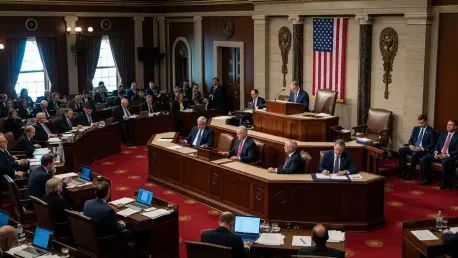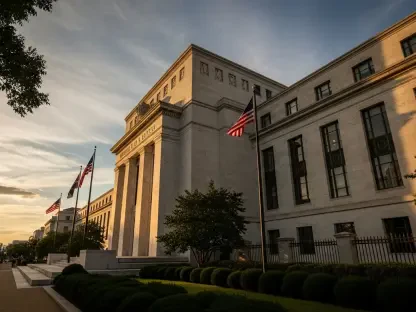I’m thrilled to sit down with Donald Gainsborough, a renowned political savant and the leader of Government Curated, whose deep expertise in congressional budget processes and executive-legislative relations offers unparalleled insight into the complex world of U.S. government spending. In this interview, we dive into the intricacies of how Congress navigates budget approvals, the evolving dynamics between the legislative and executive branches, and the unique challenges posed by partisan polarization and new tools like rescissions in the 2025 budget fight. Join us as we unpack the drama, the history, and the stakes of keeping the federal government running.
How does Congress typically go about passing a budget to keep the government operational, and what’s changed over the past few decades?
Historically, Congress aimed to pass a full, comprehensive budget each year to fund government operations. This was the norm for much of the 20th century, where lawmakers would agree on detailed spending plans for the fiscal year. However, over the last 20 to 30 years, this process has become far less common. Increasing polarization between the parties has made consensus harder to reach, and as a result, Congress often fails to pass a full budget on time. Instead, they’ve leaned heavily on temporary measures to keep things running while negotiations drag on. This shift reflects not just partisan divides but also a more closely divided Congress, where neither side often has a commanding majority to push through their priorities.
Can you break down what continuing resolutions are and why they’ve become such a staple in recent years?
Continuing resolutions, or CRs, are essentially short-term funding bills that keep the government operating at current spending levels when a full budget hasn’t been passed by the deadline. Unlike a full budget, which sets new priorities and funding levels for the year, a CR typically just extends existing allocations for a few weeks or months. They’ve become more common because the deep disagreements between Democrats and Republicans often stall long-term budget talks. With neither side willing to compromise easily, CRs act as a stopgap to avoid a government shutdown while negotiations continue. It’s a Band-Aid solution, but one that’s increasingly necessary in today’s polarized climate.
What’s the president’s role in shaping the budget process, especially when it comes to their veto power?
The president plays a pivotal role through their ability to veto any legislation, including budget bills. This means Congress must either craft a budget that the president will sign off on or muster enough votes—two-thirds in both chambers—to override a veto, which is incredibly difficult. The veto power gives the president significant leverage in negotiations, as lawmakers often need to anticipate and accommodate executive priorities to avoid a deadlock. When the same party controls both Congress and the White House, as is the case now with Republicans, alignment can smooth things over, but it also means the president’s specific demands often take center stage in shaping the final bill.
What are the key forces driving the two major parties during budget negotiations today?
Two major factors are at play. First, there’s the intense polarization between Democrats and Republicans. Compared to a few decades ago, the ideological gap between the average member of each party is much wider, making agreement on spending priorities a real challenge. Second, Congress has been more closely divided in recent years than in much of the past century. Neither party typically holds a supermajority, especially in the Senate, where you need 60 votes to overcome a filibuster on most legislation. This narrow margin means bipartisanship is often necessary but hard to achieve, as each side digs in, and Democrats, for instance, may feel excluded from talks and refuse to support a budget they didn’t help shape.
What sets the 2025 budget battle apart from those in previous years?
While many of the usual partisan tensions and internal party divides persist, what’s really different this year is the spotlight on rescissions—a tool allowing the president to request cuts to previously allocated spending. This isn’t new; it’s been around since the 1970s, but its use has surged recently. For example, earlier this year, funding cuts were proposed for public broadcasting like NPR and PBS, which stirred significant debate. Rescissions don’t require a 60-vote threshold in the Senate, just a simple majority, which changes the game. It’s created a sense of futility among Democrats, who question why they should negotiate if agreed-upon funding can just be slashed later without their consent.
How does the power of rescission alter the balance between Congress and the president?
Rescission fundamentally challenges Congress’s constitutional “power of the purse,” which is one of its core authorities under Article 1 of the Constitution. This power allows Congress to control federal spending, serving as a check on the executive branch. But when a president can request rescissions—and get them approved with just a majority vote—it undermines that leverage. It means the president can sign a budget bill and then turn around and cut parts they don’t like, effectively sidelining Congress’s role. This shift gives the executive branch unprecedented influence over spending, especially if Congress is aligned with the president’s party and willing to approve those cuts.
Given the current political climate, how does partisan loyalty in Congress affect the use of rescissions?
Right now, many Republicans in Congress are highly aligned with the president’s agenda, largely due to political pressures from their voter base. Supporting presidential requests for rescissions isn’t just about policy agreement; it’s also about avoiding backlash from constituents who expect loyalty to the administration. If Republican lawmakers resist these cuts, they risk facing criticism or even primary challenges from within their own party. This dynamic strengthens the president’s hand, as there’s a built-in incentive for many in Congress to go along with rescission requests, further tilting the balance of power toward the executive.
What is your forecast for the future use of rescissions in budget battles?
I think we’re at a crossroads. If rescissions continue to be wielded as they are now, they could become a standard tool in every budget or continuing resolution fight, fundamentally altering how Congress and the president negotiate spending. It risks turning Congress’s power of the purse into a hollow formality, where the president can veto or cut funding at will with enough partisan support in Congress. On the flip side, if opposition grows—especially if control of Congress shifts in future elections—we might see pushback or even legislative efforts to limit this authority. The trajectory depends on how lawmakers and the public respond to this erosion of traditional checks and balances over the next few years.









